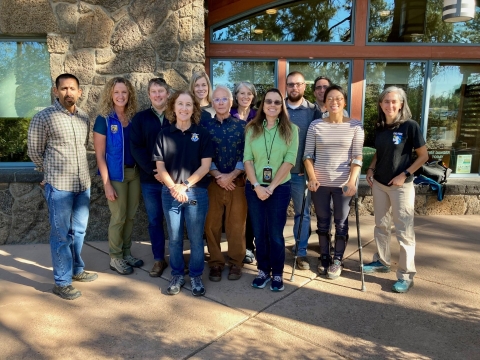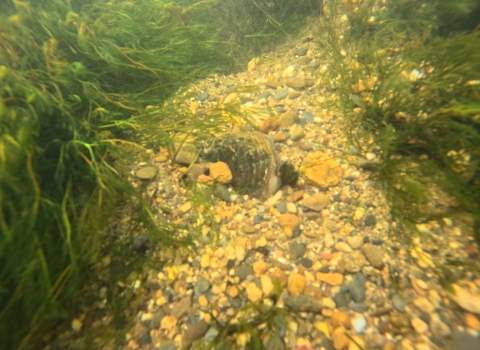By Jan Peterson, for the U.S. Fish and Wildlife Service
Bridget Moran learned in early 2024 she’d been awarded the U.S. Fish and Wildlife Service’s prestigious Meritorious Service award. She said when the award was announced at a Pacific Region meeting, she “was immediately humbled.”
“Some of my key mentors received that award, so to be considered in a group that were doing things like they were is just really humbling,” Moran said.
Moran won the award – one of the highest distinctions awarded by the Service and bestowed only once in a person’s career – for her work leading the development and implementation of the Deschutes Basin Habitat Conservation Plan (HCP).
The citation read: “Against the backdrop of the deep divisions that often accompany Western water issues, Bridget worked tirelessly to partner with local irrigation districts, farmers and conservation groups to develop the Deschutes HCP.
“Over a decade in the making, the HCP provides certainty for irrigators as well as providing conservation measures for the Oregon spotted frog and other (federally threatened) species. In the first two years of implementing the HCP, Central Oregon experienced historic drought. Bridget coordinated with the Permittees to ensure conservation measures were implemented to the maximum extent practicable, while navigating complex legal, social and political issues to keep the plan on track.
“Bridget is a creative problem solver and a highly skilled communicator whose diplomacy and frankness have earned the genuine trust of partners in the Deschutes Basin. Over the past year, the Deschutes HCP has garnered national attention as a model of collaboration to address a seemingly intractable issue, and Bridget has worked collaboratively with all members of the various Deschutes Basin stakeholders groups to share the lessons learned, and to educate them on the needs of species in the basin and the relationship between water-management objectives and actions and the life history needs of fish and wildlife.”
Moran is Field Supervisor at the Bend Field Office, Oregon Fish and Wildlife, part of the U.S. Fish and Wildlife Service’s Ecological Services program. She took a few minutes to chat about her path to the Service and her work on the HCP.
Question: Could you tell us a little about yourself and your path to this career?
Answer: I didn’t follow the traditional path of wildlife biologist. I am a toxicologist by training, and I started working for the State of Washington studying the effects of pesticides on salmon. From that, I quickly got into natural resource management.
My passion has always been for conservation. I’ve always been curious about the natural world and concerned about it, seeing the effects of growth. I always wanted to be a scientist. I was always curious.
Q: How long did it take to develop the HCP?
A: Over 12 years. I moved from Olympia, Washington, to Bend, Oregon, to help try to finish it. It still took us five years after that. I joined in 2015 and we finished in 2020. A lot of groundwork had been done, a lot of hard conversations were held, and I came in to help finish it.
It was the hardest thing I ever did, absolutely without question. My parents own restaurants that I worked at when I was young. I joked I don’t think I’ve ever worked that hard since then.
Q: What were your biggest challenges?
A: The whole new language was unfamiliar to me, and the issue was very complex. I had worked on timber plans but never water management. It was legally and politically complex. It was the confluence of technical, legal and political issues. Trying to land those three planes at the same time with really stiff sidewinds was very challenging.
I wanted to make sure our team, the community and the Service would be proud of what we were doing. That felt like a lot of pressure. And we were under a strict timeline because there were legal deadlines that made it an absolute pressure cooker for the team.
Q: You’re the award-winner, but I understand you had some big help along the way.
A: We have some absolutely amazing biologists in the service. Jennifer O’Reilly, the Oregon spotted frog lead, had to do extraordinarily challenging technical analysis and she’s just one of the best writers. She helped me understand what the frog needed so I could go in and advocate for it. Peter Lickwar was relentless in getting the bull trout measures negotiated, and Anna Soens helped pull it all together in our biological opinion. I’d also like to thank our external partners, the local irrigation partners, the Deschutes River Conservancy team, and particularly the Confederated Tribes of the Warm Springs. We worked extensively with them. They care deeply about our aquatic resources. They were key partners and allies.
Q: The write-up for the award highlights your diplomacy and your frankness as crucial to the HCP’s success. How did that play into developing the HCP?
A: I describe it as decades of intractable water conflict finally being resolved by the completion of the plan. The frankness came with just being honest and real with the applicants at the time. I let them know they needed to complete the process and that what they had offered so far wasn’t sufficient. I wasn’t trying to take advantage of that. I was there to help them get the permit they were seeking. So, I was honest and real about what they needed to provide. Then working with the conservation community, I explained what an HCP does. I think people thought it was everybody’s answer to everything. But the reality is the HCP will help restore the river somewhat, but it can’t do everything. Our goal is to have this 30-year plan be the backbone of restoration of the river.
Q: What are you looking forward to?
A: The first few years out of the gate, we were in extreme drought, so it was a challenge. This year is a good water year, so we’re glad to see the plan being implemented in less challenging times. Moving into the restoration phase is really exciting. Getting the flows established was the first big rock in the jar. Now we fill that jar up – we build on all the things that enhance those flows and improve wetlands.
Getting recognition for the project and the team – and me personally – was very exciting. I shy from the limelight because I know we stand on the shoulders of all who came before us. But it was exciting and I’m just so glad to get the project done. It truly is a lifetime achievement I’m really proud of.
The U.S. Fish and Wildlife Service has primary responsibility for protecting and recovering terrestrial and freshwater species designated as threatened and endangered under the Endangered Species Act of 1973. The law is administered by the Service and the Commerce Department’s National Marine Fisheries Service, also known as NOAA Fisheries. Today, hundreds of species are stable or improving thanks to management actions of Tribes, federal agencies, state and local governments, conservation organizations and private citizens. Our partners share a commitment to build on our accomplishments and expand innovative initiatives to further this mission in the future.






